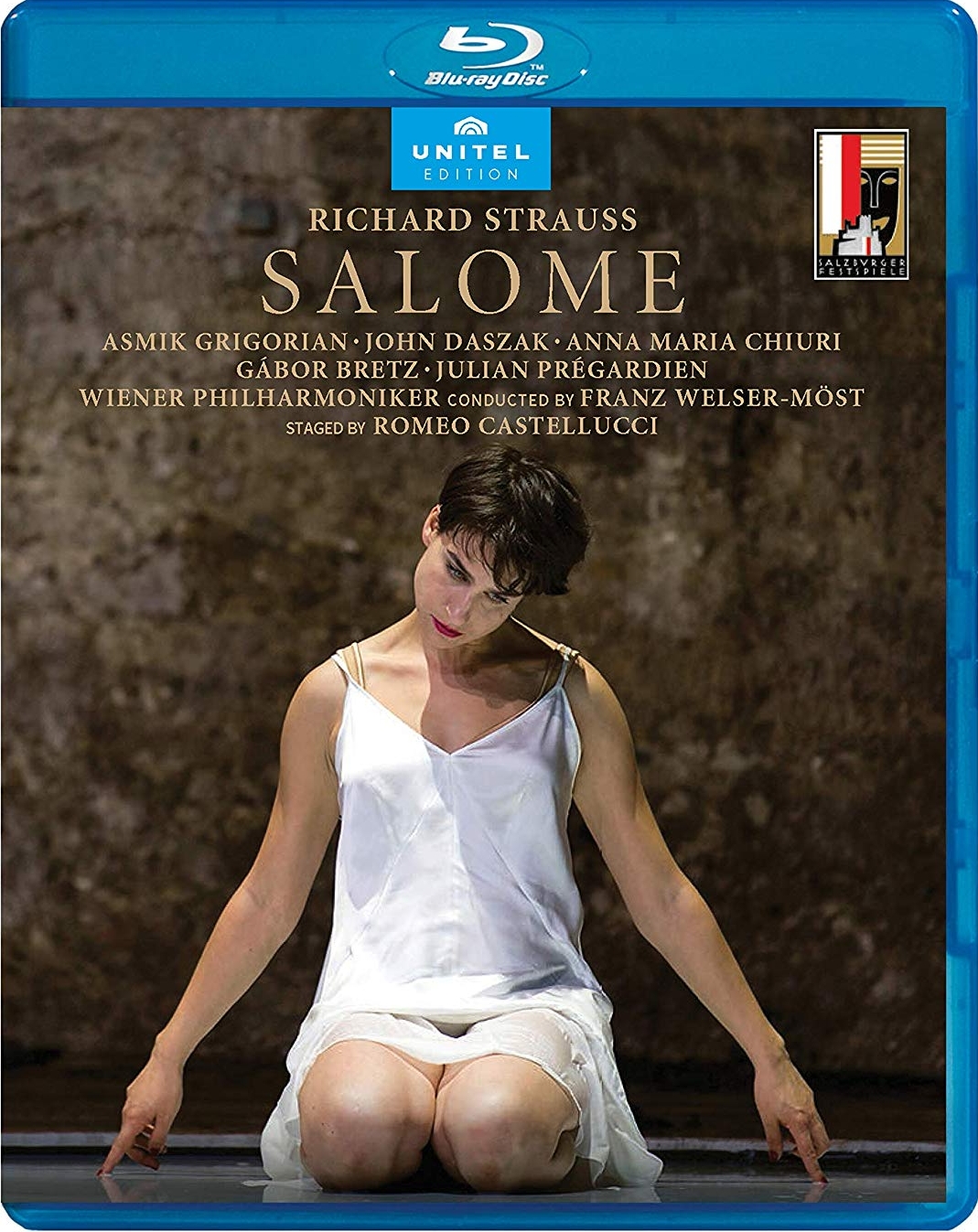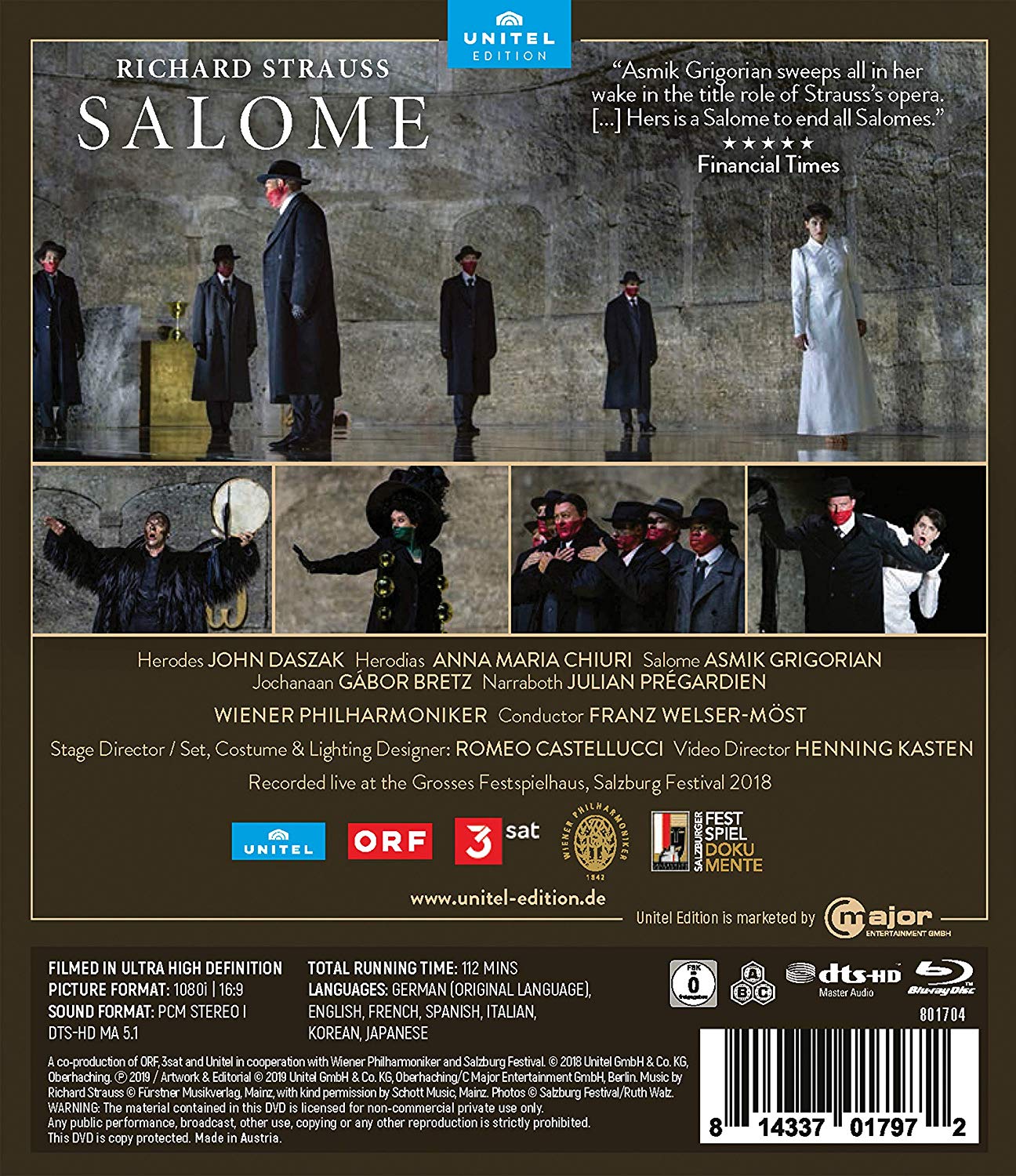

Richard Strauss Salome opera to a libretto from Hedwig Lachmann's German translation of Oscar Wilde's play Salome. Directed 2018 by Romeo Castellucci at the Großes Festspielhaus as part of the Salzburg Festival. Stars John Daszak (Herodes), Anna Maria Chiuri (Herodias), Asmik Grigorian (Salome), Gábor Bretz (Jochanaan), Julian Prégardien (Narraboth), Christina Bock (A Page of Herodias), Matthäus Schmidlechner (First Jew), Mathias Frey (Second Jew), Kristofer Lundin (Third Jew), Joshua Whitener (Fourth Jew), David Steffens (Fifth Jew), Tilmann Rönnebeck (First Nazarene), Paweł Trojack (Second Nazarene), Thomas Bennett (Kappadozier), Peter Kellner (First Soldier), and Dashon Burton (Second Soldier). Franz Welser-Möst conducts the Wiener Philharmoniker. Organ by Robert Kovacs. Sets, costumes, and lighting design by Romeo Castellucci; choreography by Cindy Van Acker; artistic collaboration by Silvia Costa; dramaturgy by Piersandra Di Matteo. Directed for TV by Henning Kasten. Sung in German. Released 2019, disc has 5.1 dts-HD Master Audio sound. Grade: B
This is a Salome for advanced opera lovers who already know the libretto and music and want something wildly different from a traditional production. Romeo Castellucci delivers this with his usual banquet of cryptic symbolism and shocking images that leaves newcomers totally baffled and the critics sharply divided between lovers and haters. The keepcase booklet has lots of technical information, but nothing to help you with the mysteries of the production.
Print critics agree, it seems, that Asmik Grigorian is outstanding as the the teen-aged sex fiend. Below is Askik’s Salome in full princess regalia waiting for Jochanaan to emerge from the cistern. We will not dwell in this review on plot elements as we have covered all that enough in reviews of other HDVDs of Salome:
Castellucci suggests that Salome was about 10 when her sexual abuse began. The blood on her gown suggests abnormal sexual psychology:
Herodias (Anna Maria Chiuriis) is described as “green figs still hanging from the tree.” Maybe this is why her she is painted green from the nose down. The faces of the men have are painted red. But Salome’s face is blank:
Salome has fled Herodes’s raucous birthday party because her step-father keeps hitting on her. She complains, “ I will not and cannot stay ”:
Now we come to a spectacular and most mysterious piece of stagecraft from Castellucci, who does his own lighting. How does one project a black image onto a set? The background is the dimly lit rear stone wall of the stage at the Felsenreitschule (the old riding school carved into the stone mountain). The familiar arches have been filled in with gray material. The creation of the black disc may be somehow connected with a scrim that must cover the entire huge opening of the stage. Or is the black disc some kind of balloon? The image of the black disc suggests the cistern pit in the floor which holds Jochanaan (John the Baptist) prisoner. A white spotlight illuminates the center of the disc so an audience member can see a figure (poorly) in front of the black disc. A different spotlight seems to come from the left rear of the audience to illuminate Salome, who casts a curious double shadow-like image on the rear wall. This may have looked intriguing in the live show, but is just weird in the home theater:
In the libretto, Jochanaan is depicted as an emaciated political prisoner and preacher who is pale as ivory. Here we get an American Plains Indian drenched in wet carbon-black! He is cursing Salome as a “daughter or Sodom.”
The next 3 screenshots below show image defects we associate with the lighting and creation of the black disc:
Many inexplicable images crop up throughout this recording such as the boxers seen next below. The body below is Narraboth, the Captain of the Guard, who committed suicide early in the show. Herodes ordered that his body be removed, but it is still there:
The Greek abbreviations on the wall stand for “John the Prophet.” Salome has been rejected and cursed by John, but this only whets her desire as she wallows in sexual ecstasy thinking about him. Castellucci likes to put large beasts on stage, a most dangerous kind of prop. Here a huge dark horse appears as a symbol of John (keeping the animal in the pit helps avoid accidents). At least Castellucci uses herbivores. (Which would be the more horrible way to die: to be crushed by an angry hippo or eaten by a hungry lion?)
Hoping for a sexy dance from Asmik? Forget it. In stead of a dance we see Salome bound on top of the throne of Herodes, shown below as a large brass cube with the Latin word “stones” on it:
What appears to be a huge stone is lowered and it seems Salome will be crushed:
But Salome survives. Herodes, astonished at what appears to be a magic trick, declares, “Herrlich. What can I bring you on a silver platter?”
Workers pour milk into a shallow basin. Salome says “I want the head for me. I’m not listening to my mother”:
Instead of John’s head, Salome gets his body. She also gets the head of the black horse. The Greek abbreviation for “Prophet” has disappeared from the wall. Next below Salome asks the horse’s head, “Why don’t you look at me?”
Why didn’t you look at me, John?”
“I have kissed your mouth!”
In August 2018, Joshua Barone saw this production as a reporter for the New York Times. He later had an interview with Castellucci who graciously explained his ending as follows (in paraphrase): The milk stands for the purity of Salome’s childhood. But now she is a debauched woman. She fell in love with John dreaming of the possibility of escape. She asks for John’s head because she thought it would make her a complete individual. But when she sees the head of the horse, she realizes the head on the silver platter will be hers. She and John will share the same destiny.
So what to make of this? Is it profound or merely pretentious? Most of the print critics who saw it live were enthusiastic. Gramophone gave this its Blu-ray of the Month award in October 2019. Others were harshly critical. We think there may be some productions that will be impressive live but not very attractive in a recording. We find that the inscrutability of Castellucci’s concepts together with the technical issues with PQ noted suggest a B grade for this recording. If you are especially interested in soprano singing, this would rate a higher grade for you.
Here’s a clip from C Major which probably is entirely from the Blu-ray disc:
And next below are two clips from the production that may not be exactly what you see on the disc, but which still give you fair warning about what you are getting into with this:
OR


















